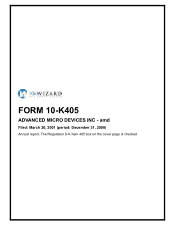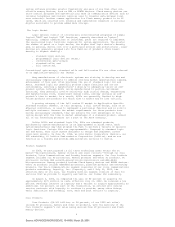AMD 2000 Annual Report Download - page 9
Download and view the complete annual report
Please find page 9 of the 2000 AMD annual report below. You can navigate through the pages in the report by either clicking on the pages listed below, or by using the keyword search tool below to find specific information within the annual report.-
 1
1 -
 2
2 -
 3
3 -
 4
4 -
 5
5 -
 6
6 -
 7
7 -
 8
8 -
 9
9 -
 10
10 -
 11
11 -
 12
12 -
 13
13 -
 14
14 -
 15
15 -
 16
16 -
 17
17 -
 18
18 -
 19
19 -
 20
20 -
 21
21 -
 22
22 -
 23
23 -
 24
24 -
 25
25 -
 26
26 -
 27
27 -
 28
28 -
 29
29 -
 30
30 -
 31
31 -
 32
32 -
 33
33 -
 34
34 -
 35
35 -
 36
36 -
 37
37 -
 38
38 -
 39
39 -
 40
40 -
 41
41 -
 42
42 -
 43
43 -
 44
44 -
 45
45 -
 46
46 -
 47
47 -
 48
48 -
 49
49 -
 50
50 -
 51
51 -
 52
52 -
 53
53 -
 54
54 -
 55
55 -
 56
56 -
 57
57 -
 58
58 -
 59
59 -
 60
60 -
 61
61 -
 62
62 -
 63
63 -
 64
64 -
 65
65 -
 66
66 -
 67
67 -
 68
68 -
 69
69 -
 70
70 -
 71
71 -
 72
72 -
 73
73 -
 74
74 -
 75
75 -
 76
76 -
 77
77 -
 78
78 -
 79
79 -
 80
80 -
 81
81 -
 82
82 -
 83
83 -
 84
84 -
 85
85 -
 86
86 -
 87
87 -
 88
88 -
 89
89 -
 90
90 -
 91
91 -
 92
92 -
 93
93 -
 94
94 -
 95
95 -
 96
96 -
 97
97 -
 98
98 -
 99
99 -
 100
100 -
 101
101 -
 102
102 -
 103
103 -
 104
104 -
 105
105 -
 106
106 -
 107
107 -
 108
108 -
 109
109 -
 110
110 -
 111
111 -
 112
112 -
 113
113 -
 114
114 -
 115
115 -
 116
116 -
 117
117 -
 118
118 -
 119
119 -
 120
120 -
 121
121 -
 122
122 -
 123
123 -
 124
124 -
 125
125 -
 126
126 -
 127
127 -
 128
128 -
 129
129 -
 130
130 -
 131
131 -
 132
132 -
 133
133 -
 134
134 -
 135
135 -
 136
136 -
 137
137 -
 138
138 -
 139
139 -
 140
140 -
 141
141 -
 142
142 -
 143
143 -
 144
144 -
 145
145 -
 146
146 -
 147
147 -
 148
148 -
 149
149 -
 150
150 -
 151
151 -
 152
152 -
 153
153 -
 154
154 -
 155
155 -
 156
156 -
 157
157 -
 158
158 -
 159
159 -
 160
160 -
 161
161 -
 162
162 -
 163
163 -
 164
164 -
 165
165 -
 166
166 -
 167
167 -
 168
168 -
 169
169 -
 170
170 -
 171
171 -
 172
172 -
 173
173 -
 174
174 -
 175
175 -
 176
176 -
 177
177 -
 178
178 -
 179
179 -
 180
180 -
 181
181 -
 182
182 -
 183
183 -
 184
184 -
 185
185 -
 186
186 -
 187
187 -
 188
188 -
 189
189 -
 190
190 -
 191
191 -
 192
192 -
 193
193 -
 194
194 -
 195
195 -
 196
196 -
 197
197 -
 198
198 -
 199
199 -
 200
200 -
 201
201 -
 202
202 -
 203
203 -
 204
204 -
 205
205 -
 206
206 -
 207
207 -
 208
208 -
 209
209 -
 210
210 -
 211
211 -
 212
212 -
 213
213 -
 214
214 -
 215
215 -
 216
216 -
 217
217 -
 218
218 -
 219
219 -
 220
220 -
 221
221 -
 222
222 -
 223
223 -
 224
224 -
 225
225 -
 226
226 -
 227
227 -
 228
228 -
 229
229 -
 230
230 -
 231
231 -
 232
232 -
 233
233 -
 234
234 -
 235
235 -
 236
236 -
 237
237 -
 238
238 -
 239
239 -
 240
240 -
 241
241 -
 242
242 -
 243
243 -
 244
244 -
 245
245 -
 246
246 -
 247
247 -
 248
248 -
 249
249 -
 250
250 -
 251
251 -
 252
252 -
 253
253 -
 254
254 -
 255
255 -
 256
256 -
 257
257 -
 258
258 -
 259
259 -
 260
260 -
 261
261 -
 262
262 -
 263
263 -
 264
264 -
 265
265 -
 266
266 -
 267
267 -
 268
268 -
 269
269 -
 270
270 -
 271
271 -
 272
272 -
 273
273 -
 274
274 -
 275
275 -
 276
276 -
 277
277 -
 278
278 -
 279
279 -
 280
280 -
 281
281 -
 282
282 -
 283
283 -
 284
284 -
 285
285 -
 286
286 -
 287
287 -
 288
288 -
 289
289 -
 290
290 -
 291
291 -
 292
292 -
 293
293 -
 294
294 -
 295
295 -
 296
296 -
 297
297 -
 298
298 -
 299
299 -
 300
300 -
 301
301 -
 302
302 -
 303
303 -
 304
304 -
 305
305 -
 306
306 -
 307
307 -
 308
308 -
 309
309 -
 310
310 -
 311
311 -
 312
312 -
 313
313 -
 314
314 -
 315
315 -
 316
316 -
 317
317 -
 318
318 -
 319
319 -
 320
320 -
 321
321 -
 322
322 -
 323
323 -
 324
324 -
 325
325 -
 326
326 -
 327
327 -
 328
328 -
 329
329 -
 330
330 -
 331
331 -
 332
332 -
 333
333 -
 334
334 -
 335
335 -
 336
336 -
 337
337 -
 338
338 -
 339
339 -
 340
340 -
 341
341 -
 342
342 -
 343
343 -
 344
344 -
 345
345 -
 346
346 -
 347
347 -
 348
348 -
 349
349 -
 350
350 -
 351
351 -
 352
352 -
 353
353 -
 354
354 -
 355
355 -
 356
356 -
 357
357 -
 358
358 -
 359
359 -
 360
360 -
 361
361 -
 362
362 -
 363
363 -
 364
364 -
 365
365 -
 366
366 -
 367
367 -
 368
368 -
 369
369 -
 370
370 -
 371
371 -
 372
372 -
 373
373 -
 374
374 -
 375
375 -
 376
376 -
 377
377 -
 378
378 -
 379
379 -
 380
380 -
 381
381 -
 382
382 -
 383
383 -
 384
384 -
 385
385 -
 386
386 -
 387
387 -
 388
388 -
 389
389 -
 390
390 -
 391
391 -
 392
392 -
 393
393 -
 394
394 -
 395
395 -
 396
396 -
 397
397 -
 398
398 -
 399
399 -
 400
400 -
 401
401 -
 402
402 -
 403
403 -
 404
404 -
 405
405 -
 406
406 -
 407
407 -
 408
408 -
 409
409 -
 410
410 -
 411
411 -
 412
412 -
 413
413 -
 414
414 -
 415
415 -
 416
416 -
 417
417 -
 418
418 -
 419
419 -
 420
420 -
 421
421 -
 422
422 -
 423
423 -
 424
424 -
 425
425 -
 426
426 -
 427
427 -
 428
428 -
 429
429 -
 430
430 -
 431
431 -
 432
432 -
 433
433 -
 434
434
 |
 |
PC Processors
In 2000, our most significant microprocessor product sales were from the
AMD Athlon(TM) and AMD Duron(TM) processors, our seventh-generation
microprocessor products. The AMD Athlon and AMD Duron microprocessors are based
on superscalar RISC architecture and are designed to be compatible with
operating system software such as Windows 2000, Windows NT(R), Windows 98 (and
their predecessor operating systems), Linux, Netware and UNIX.
We began volume shipments of AMD Athlon microprocessors in the second half
of 1999. The AMD Athlon processor is an x86-compatible, seventh-generation
design featuring:
. a superpipelined, nine-issue superscalar microarchitecture optimized for
high clock frequency;
. a fully pipelined, superscalar floating point unit;
. high-performance backside L2 cache interface;
. enhanced 3DNow!(TM) technology with 24 additional instructions designed
to improve integer math calculations, data movements for Internet
streaming, and digital signal processor (DSP) communications; and
. a system bus which is a 200 MHz system interface based on the Alpha(TM)
EV6 bus protocol with support for scalable multiprocessing.
We began shipments of AMD Duron processors in the second half of 2000. The
AMD Duron processor, a derivative of the AMD Athlon processor core, is designed
to provide an optimized solution for value-conscious business and home users,
and features:
. full-speed, on-chip L2 cache memory;
. a 200 MHz front side system bus; and
. a superscalar floating point unit with enhanced 3DNow! technology.
Our overall PC processor sales growth in 2001 depends upon a continuing
successful production ramp in Dresden Fab 30, timely volume availability of
chipsets and motherboards from third party suppliers and increasing commercial
and consumer market acceptance of AMD Athlon and AMD Duron microprocessors.
Our microprocessor products have and will continue in 2001 and 2002 to
make significant contributions to our overall revenues, profit margins and
operating results. We plan to continue to make significant capital expenditures
to support our microprocessor products both in the near and long term. Our
ability to increase microprocessor product revenues, and benefit fully from the
substantial financial investments and commitments we have made and continue to
make related to microprocessors, depends upon the success of our seventh-
generation and future generations of microprocessors beginning with the "Hammer"
family of microprocessors that we plan to introduce in 2002. The Hammer
processors will be our first processors capable of 64-bit operation, and are
being designed to deliver leading-edge performance on both the 64-bit software
used by high-end workstations and servers and the 32-bit software used by the
majority of desktop users.
The microprocessor market is characterized by short product life cycles and
migration to ever higher performance microprocessors. To compete successfully
against Intel in this market, we must transition to new process technologies at
a fast pace and offer higher performance microprocessors in significantly
greater volumes. We must achieve acceptable yields while producing
microprocessors at higher speeds.
Intel has dominated the market for microprocessors used in PCs for many
years. Because of its dominant market position, Intel has historically set and
controlled x86 microprocessor and PC system standards and, thus, dictated the
type of product the market requires of Intel's competitors. In addition, Intel
may and does vary prices on its microprocessors and other products at will and
thereby affects the margins and profitability of its competitors due to its
financial strength and dominant position. Intel also exerts substantial
influence over PC manufacturers and their channels of distribution through the
"Intel Inside" brand and other marketing programs. Intel invests billions of
dollars in, and as a result exerts influence over, many other technology
companies. We expect Intel to continue to invest heavily in research and
development, new manufacturing facilities and other technology companies, and to
remain dominant:
. through the Intel Inside and other marketing programs;
. through other contractual constraints on customers, retailers, industry
suppliers and other third parties;
. by controlling industry standards; and
. by controlling supply and demand of motherboards, chipsets and other
system components.
5
Source: ADVANCED MICRO DEVIC, 10-K405, March 20, 2001
